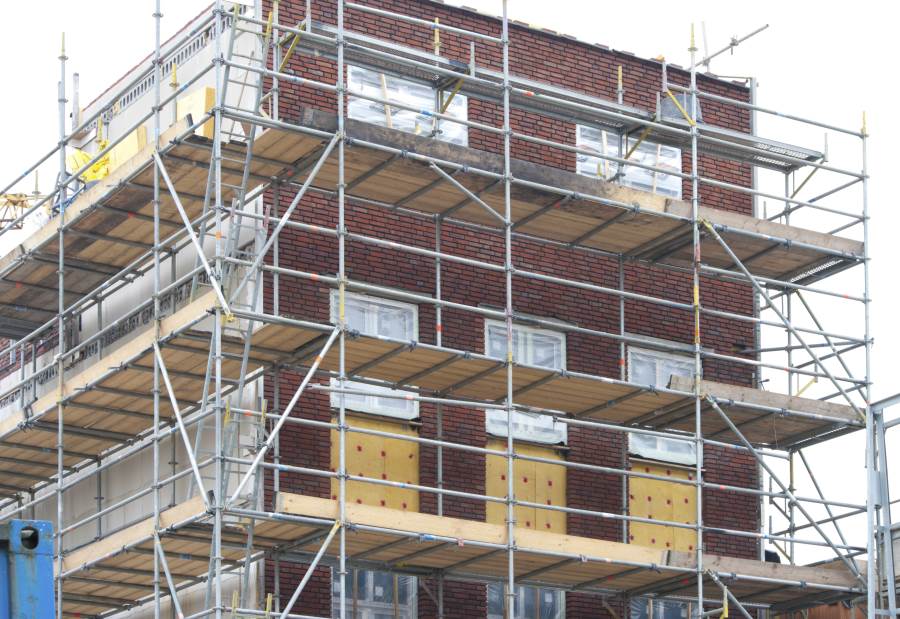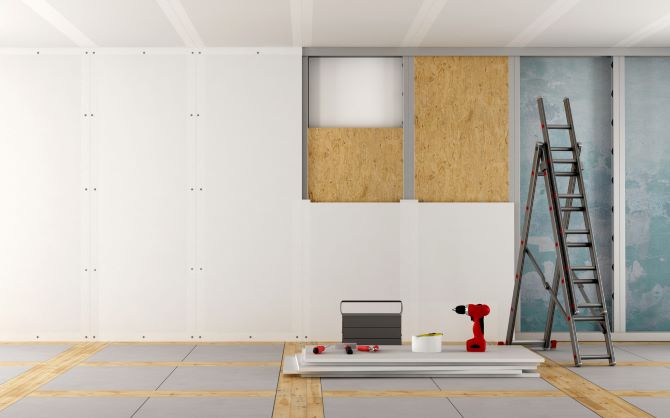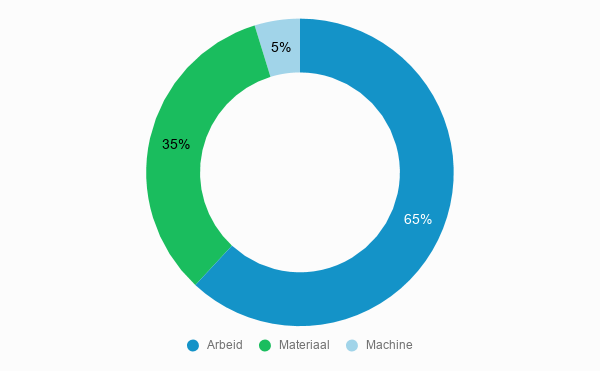Do you like having a warm and well-insulated house, but a lot of heat is lost through the walls? Is cavity wall insulation not enough, or not possible? Wall insulation keeps the heat in your home. This is good for the environment and for your wallet. How much this investment will cost you and which options you have, you will discover in this article.
What does facade insulation cost?
On average, facade insulation costs £7,000 to £11,000, including installation. You have a choice of two insulation measures: interior wall insulation and exterior wall insulation. Both interior and exterior wall insulation use insulation boards. See the cost overview below for the average prices per type of facade insulation per house type.
| House type (opp) | Interior facade | Exterior facade |
|---|---|---|
| Appartment (25 m²) | £ 1,500 – £ 2,250 | £ 2,500 – £ 3.250 |
| Intermediate house (50 m²) | £ 3,000 – £ 4,500 | £ 5,000 – £ 6,500 |
| Corner house / semi-detached house (100 m²) | £ 6.000 – £ 9,000 | £ 10,000 – £ 13,000 |
| Detached (180 m²) | £ 11,000 – £ 16,000 | £ 18,000 – £ 23.500 |
Find the best specialist for your project and get free quotes.
Start

Price examples
To give you an idea of the costs and options, two situations have been outlined:
The cheapest option
You live in a corner house, and you want to better insulate your home so that you can heat your home with a heat pump. For this, only cavity wall insulation is in fact not always enough. You don’t like the idea of exterior wall insulation because it changes the appearance of your house. In this case, opt for interior wall insulation. This will give your house extra insulation. This inner wall insulation will cost you between £6,000 and £9,000 for 100 m2.
Highest savings on your energy bill
You have a beautiful detached house, but the energy costs are on the high side. You want to save as much as possible and the municipality is willing to give you a permit to change the appearance of your home. Then you choose to have external wall insulation installed, which will reduce heating costs but also make the temperature in your home more comfortable. You can have external wall insulation, including new cladding, installed for between £18,000 and £23,500 for 180 m2. This is the amount excluding any subsidies.
What is covered by facade insulation?
When do you actually speak of facade insulation? If you own a house for which cavity wall insulation is not an option, or if you want to insulate your house better than is possible with cavity wall insulation alone, then facade insulation is the solution. Facade insulation can be done through both interior and exterior facade insulation.
Interior facade insulation
Interior facade insulation, as the name suggests, involves insulating the inside of the walls. This can be done in different ways. In most cases, professionals use ready-made panels or a pre-wall. However, aerated concrete or hemp blocks are also possible. The insulation values of these methods depend on the insulation material used.
With ready-made panels, insulation boards that have already been provided with a vapour control layer and a plasterboard are placed on the wall. This is done against a vertical insulation strip that prevents thermal bridges and creates a small cavity. This therefore does not require the installation of a wooden framework against the wall.
With a false wall, a wooden framework is installed, which is filled with insulation boards. This insulating wall is then covered with boards of wood or plaster, after which the wall can be painted or wallpapered.
Finally, if you choose aerated concrete or hemp blocks, these are glued to the wall if the wall is level enough. If not, a mini cavity can be realised. These blocks do not insulate as well as insulation materials such as PIR boards or rock wool do.
Pre- and disadvantages of interior wall insulation
The biggest advantages of interior wall insulation are, of course, the savings on energy costs and the fact that you can make the insulation layer thicker or thinner as you wish. You also don’t need a permit, unless you live in a listed building where the interior is also listed.
Advantages:
- Saving on energy costs
- Costlier than external wall insulation
- No permit is needed (except in the case of monumental interiors)
- Also possible for houses without a cavity
- Each room can be insulated separately
If we look at the disadvantages, besides the investment, the loss of space is the biggest one. This loss of space will mainly occur in corner houses, semi-detached houses and detached houses. In flats and mid-terrace houses the loss is in fact less due to the relatively larger window area in the outer walls of these houses.
Disadvantages:
- Loss of space in the room
- Plugs, radiators etc may have to be relocated
- More expensive than cavity wall insulation
- Coom must be empty during insulation

Exterior wall insulation
With exterior wall insulation, insulation material is not applied to the inside, but rather to the outside of the wall. First of all, the specialist glues insulation boards to the outer walls, after which the insulation material is covered with cladding in the form of, for example, stone strips, plastering or siding.
So you make the outer walls somewhat thicker. With thin insulation, the window frames can remain in place. If a thicker layer is applied, the window frames will also be adjusted. If your window frames already need replacing, this is an excellent time to do so. For more information, check our article on external wall insulation.
Pre- and disadvantages of external wall insulation
External wall insulation also has both advantages and disadvantages. The biggest advantage of this form of facade insulation over the indoor variant is the lack of loss of space. You won’t notice anything in terms of living space. External façade insulation has a high efficiency and therefore ensures considerably lower energy costs.
Advantages:
- Saving on energy costs
- Isolation without loss of space in the house
- Also possible for houses without a cavity
- Good for the climate, because less CO2 emissions
- Provides an as good as new external wall with a new look
Having external wall insulation installed is quite an investment. Another disadvantage is the fact that you cannot have this insulation measure done just like that. Because exterior wall insulation involves changing the appearance of your home, you have to apply for a permit. If you live in a listed building or if your house is a protected townscape, for example, this insulation measure is not allowed.
Disadvantages:
- Favourable investment
- Licence required
- Adaptation to windows may be necessary with thick insulation layer
What insulation materials are suitable for facade insulation?
There is a range of insulation materials that can be used for facade insulation. For example, insulation boards of the five most commonly used insulation materials are possible: EPS, PIR, PUR, glass wool and rock wool. However, there are many other alternatives. Consider, for example, materials such as hemp fibre, wood fibre, sheep’s wool, flax wool, cork or cotton. Resol rigid foam boards and XPS can also be used for facade insulation. A specialist can advise you on the best choice for your situation.
Would you like to be eligible for a subsidy? Then keep in mind the conditions set by the government when choosing your insulation material. A complete list of all materials they consider suitable for facade insulation, the Insulation Measures List, can be found on the website of the RVO.
The VAT rate on facade insulation
A financial windfall if you are going to install facade insulation: when insulating a house with the aim of making it more energy efficient, you do not pay 21% VAT, but only 9%. This VAT rate applies to the labour costs involved in these measures. Your home must be 2 years or older for this. Insulation materials themselves are subject to the 21% VAT rate.
Subsidy for facade insulation
The government provides subsidies through the ISDE insulation scheme to homeowners who take one or two insulation measures. This can also be one insulation measure, for example floor insulation, combined with a heat pump, solar boiler or connection to a heat network.
So, apart from facade insulation, are you planning to have another measure carried out? Then check on the website of the RVO what conditions these measures must meet to be eligible for a subsidy. You must live in the house yourself, certain insulation values must be achieved and the insulation measure must be carried out by a company.
What does the price of facade insulation consist of?

The total price for the installation of facade insulation consists of labour costs, machine costs and material costs. Labour costs take up the largest share here. This cost is about 60 per cent of the total cost. Therefore, compare quotes to find the specialist with the best deal on labour costs. You have less influence on the machine costs, but you can influence the cost of the material by choosing the insulation material that suits you.
Find the best specialist for your project and get free quotes.
Start